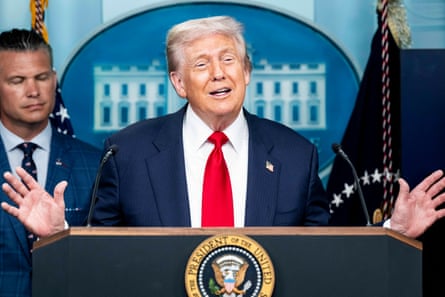As Donald Trump convened reporters at the White House on Monday morning to announce his plans for sending the national guard on to Washington DC streets and taking over the police department, protesters gathered a block away to denounce what they saw as his plans to put the federal district under his thumb.
“Nothing Trump is doing right now is about our safety,” Keya Chatterjee, executive director of Free DC, a group advocating for the city’s autonomy, told the 200 or so people gathered on a block of 16th Street Northwest that had once been called Black Lives Matter Plaza, before the city government ordered the name stripped shortly after Trump’s inauguration this year.
“What we know from history is that authoritarians always want to control the capital and the people in the capital city. It’s because it’s the fastest way to silence dissent and to accelerate their agenda. And I want to be clear, this is not about crime. This is about what Trump is trying to do to DC in order to take over DC and silence us.”
Lamont Mitchell was not so sure. A lifelong Washingtonian who resides among the poorer and more crime-stricken neighborhoods east of the Anacostia river, he regarded Trump’s plans for the homeless as “inhumane”, but was open to his ideas for making the city’s streets safer. Mitchell described how he avoids certain areas on drive way home for fear of being struck by a stray bullet, no longer walks down certain blocks, had his RV stolen and plans to buy a gun.
“As a senior in Washington, I need to feel safe,” said 69-year-old Mitchell, who chairs the Anacostia Coordinating Council community organization. “We gotta take drastic action when drastic action is called for.”
The overwhelmingly Democratic federal district is the latest American city to which Trump has deployed troops since taking office, after sending active-duty marines and national guard into Los Angeles in June to quell protests over immigration enforcement. This time, the foe is crime that the president argues is “out of control”, and the catalyst is the attack of a staffer from the “department of government efficiency” in a relatively safe neighborhood earlier this month.
Mayor Muriel Bowser has called Trump’s intervention “unsettling and unprecedented”, as well as unwarranted. City leaders have pointed to statistics that show crimes such as robbery, homicide and assault with a deadly weapon are down, and violent crime hit a 30-year low in 2024.
Yet Washington continues to struggle with rates of violent crime that are higher than cities with similar populations, according to the Real-Time Crime Index from AH Datalytics. Residents are used to hearing reports of violence, though much of it occurs in the city’s poorer, majority Black eastern third, far from the museums and monuments of the National Mall.
They are also used to seeing a lot of police – about 50 law enforcement agencies are already in Washington DC, ranging from the citywide Metropolitan police department (MPD) to the obscure zoo police, FBI police and Federal Reserve police, which provide security around specific agencies.
National guard troops and agents from the FBI and Immigrations and Customs Enforcement (Ice) are now expected to be on the streets along those officers, but residents are unsure whether they will make much difference.
“I tend to be pretty cynical about what the Trump administration is doing right now. This seems pretty clearly just like red meat to throw to his base, this announcement on a Monday,” said Brian Strege, a neighborhood commissioner in Navy Yard, where mobs of juveniles have appeared repeatedly over the summer, shooting off fireworks and harassing bystanders.
“I get the sense it’s just going to be a lot of bored national guard troops wandering around the city.”
Trump made mention of the disturbances in Navy Yard during his White House press conference, but Strege said the city had already taken steps to stop the disorder, including by instituting a nighttime curfew this summer for people under 18. Trump plans to take over the police department for 30 days – right around the time schools resume, and Strege said the teenagers typically stop showing up.

“Thirty days from now is going to be September. Our juvenile crime is likely to decrease, because it always does. So, it sounds like they’re going to pretend that it went down because they did this big deployment,” he said. “I don’t see it helping really at all. I think our police force has actually been doing a pretty good job over the past few years.”
Last Saturday night saw more teenagers flood Navy Yard, as well as a shooting. The following day, Edward Daniels, another neighborhood commissioner in the area, saw Ice agents patrolling the street, and at one point stopping some teenagers from riding bikes, which others had used in the past to harass people.
Their presence, he said, didn’t make him feel safe, but rather concerned – did these agents know how to patrol a city? Were they coordinating with the police department?
“It’s going to make things even more chaotic here and cause what I believe to be even more dangerous situations than what we’ve seen here on the ground,” he said.
Across the Anacostia river, Sandra Seegars, a longtime anti-crime activist, welcomed Trump’s announcement. Her Congress Heights neighborhood has one of the highest homicide rates in the city, according to police data, and she was pleased to hear from a friend that federal agents had been spotted in a nearby park.
“He’s going to make me feel safer,” Seegars said of Trump’s deployment. “I think he’s doing the right thing. He should have done it before now.”

 German (DE)
German (DE)  English (US)
English (US)  Spanish (ES)
Spanish (ES)  French (FR)
French (FR)  Hindi (IN)
Hindi (IN)  Italian (IT)
Italian (IT)  Russian (RU)
Russian (RU)  6 hours ago
6 hours ago
























Comments